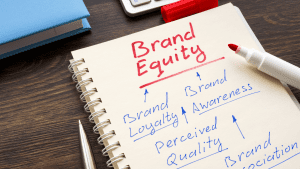

Brand Marketing is Dead. Here’s What You Should Invest in 2025
Discover why traditional brand marketing won’t drive success in 2025 and how to pivot your strategy toward exceptional products and customer experiences for lasting growth.


If consumers don’t know about your brand, they’re unlikely to consider purchasing from you. Discover how to increase brand awareness and learn why it’s crucial in the guide below.
Welcome to your go-to guide for ramping up brand awareness! Whether you’re launching a startup, refreshing a seasoned brand, or simply eager to gain a stronger foothold in your market, understanding the essence of brand awareness is pivotal. This guide is crafted to not only enlighten you but also equip you with practical strategies to amplify your brand’s visibility. So grab your favorite beverage, settle in, and let’s dive into the world of brand building!
Brand awareness is essentially how recognizable your brand is to your target audience. It measures how familiar potential and existing customers are with your brand’s name, logo, messaging, and overall identity. The higher the brand awareness, the more people are aware of the qualities and image of your brand without needing a detailed reminder.
Think of brand awareness as the first layer of building a relationship with your audience. It’s not just about knowing the brand name; it’s about how deeply a consumer feels connected to your brand through various touchpoints. These can range from seeing your ads, recognizing your packaging on a store shelf, hearing about you from a friend, or even noticing a mention on social media.
Brand awareness is crucial because it sets the foundation for attracting and retaining customers. When someone needs a product or service that you offer, you want your brand to be the first that comes to their mind. Achieving this top-of-mind awareness means that your brand has made a significant impression on consumers, influencing their purchase decisions positively.
When we talk about brand awareness, we are also discussing the concept of brand recall and brand recognition:
Both elements play a pivotal role in the consumer’s journey from awareness to purchase, underscoring the importance of a strong and memorable brand presence in the market.
By understanding and improving your brand awareness, you’re not just increasing how many people know of your brand, but also enhancing how they perceive it emotionally and intellectually. This, in turn, builds a stronger, more loyal customer base.
Brand awareness isn’t just a buzzword—it’s a crucial element of your business’s success. But why is it so important? Let’s break down the reasons that make brand awareness a top priority for any business aiming to grow and succeed in a competitive market.
The first step in a consumer’s decision-making process often begins with brand recognition. When consumers recognize and are familiar with a brand, they are more likely to trust it. This trust is fundamental, especially in markets saturated with choices. A familiar brand feels safer to consumers, which can significantly influence their buying decisions. Essentially, the more people know your brand, the more they trust it, and the more likely they are to purchase from it – that’s where brand perception comes into play.
In today’s competitive business environment, standing out is more important than ever. High brand awareness sets you apart from competitors, ensuring that potential customers think of your brand first when considering their options. This top-of-mind awareness can directly influence consumer behavior, steering customers towards your products and services over others.
Launching a new product is much easier when you have established brand awareness. Consumers who are already familiar with your brand are more likely to try new products under the same brand umbrella. This familiarity reduces the risk associated with trying something new and can accelerate the acceptance and success of new market entries.
Brand awareness amplifies the impact of your marketing campaigns. When people are aware of your brand, they are more likely to engage with your content, understand your messages, and respond to your calls to action. It creates a fertile ground for your marketing efforts, enhancing reach and efficacy across different channels and increasing brand awareness.
Brand awareness is a key component of brand equity, which refers to the value derived from a well-known brand name. High brand awareness contributes to higher brand equity, which means better financial returns, more favorable deals, and a stronger bargaining position in the market. It can also lead to brand loyalty, and brand association where customers continue to choose your brand over others because of the positive association they have with it.
Measuring brand awareness might seem like trying to catch smoke—it’s intangible and often elusive. But fear not! There are several effective methods to gauge how visible and recognizable your brand really is. Understanding these metrics not only helps you see where you stand but also guides you in fine-tuning your strategies for better market penetration.
One of the most straightforward methods to measure brand awareness is through surveys. Ask your target audience direct questions like:
This method helps in measuring both aided and unaided brand recall and gives you a clear picture of your brand’s visibility in the minds of consumers.
Social media platforms are gold mines for brand awareness data. Tools like Hootsuite, Sprout Social, or Mention can track how often your brand is mentioned across these platforms. High engagement rates and frequent mentions usually indicate high brand awareness. Moreover, you can analyze the sentiment of these mentions to gauge public perception of your brand.
Your website analytics can tell you a lot about your brand’s visibility. Metrics to focus on include:
Google Trends, Keyword Planner, and other SEO tools can show you how many times your brand’s name is searched in search engines. An increase in search volume over time can signify growing brand awareness.
Earned media—mentions in news outlets, articles, blogs, and other third-party resources—can be a potent indicator of brand awareness. Tools like Google Alerts can help you track these mentions and assess how widespread your brand recognition is.
Feedback from review sites like Yelp, Google Reviews, or industry-specific platforms provides insights into brand perception. Positive reviews and high ratings generally correlate with strong brand awareness and a positive brand image.
It’s crucial to combine these quantitative measures with qualitative insights to get a comprehensive view of your brand’s market presence. By blending data-driven metrics with anecdotal evidence from customer interactions, you can paint a more accurate picture of your brand’s awareness and its impact on your target audience.
Creating brand awareness is much like planting a garden. It requires planning, nurturing, and continuous effort. When done right, it helps your brand flourish and stand out in a crowded marketplace. Here are actionable strategies that can effectively boost your brand’s visibility and make it memorable.
Every brand has a story, and sharing yours can connect emotionally with your audience. Whether it’s the inspiration behind starting your business, the challenges you’ve overcome, or the impact you wish to make, a compelling narrative can make your brand more relatable and memorable. Use your website, social media, and marketing materials to tell your story in an engaging way.
In the digital age, an online presence is crucial. Ensure your website is visually appealing, easy to navigate, and optimized for search engines. Regularly update your content to keep it fresh and relevant. Similarly, maintain active social media profiles where you engage with followers, share valuable content, and participate in conversations relevant to your industry.
Content marketing is a powerful tool for building brand awareness. Create high-quality, valuable content that addresses your audience’s needs and interests. This could include blog posts, videos, podcasts, infographics, or eBooks. Not only does this establish your brand as an authority in your field, but it also keeps people coming back for more.
Social media extends your reach and is essential for building brand awareness. Choose platforms that best align with your brand’s demographic and post regularly. Use a mix of content types to engage your audience, including behind-the-scenes posts, customer testimonials, and live videos. Engaging with users and responding to comments can also enhance your brand’s visibility and appeal.
Search engine optimization (SEO) increases your brand’s online visibility. Research keywords that are relevant to your brand and incorporate them into your website and content. This can improve your search engine rankings and make it easier for potential customers to find you when they search for related topics.
Partnering with influencers who align with your brand can tap into their audience and generate awareness. Choose influencers who share your brand values and have an engaged audience likely to be interested in your products or services.
Participating in community events or hosting your own can increase brand visibility and strengthen connections with your audience. Whether it’s a local fair, a trade show, or an online webinar, events are a great opportunity to showcase your brand and interact directly with potential customers.
Paid advertising, whether online or offline, can be a quick way to increase brand awareness. Platforms like Google Ads or social media advertising allow you to target specific demographics, increasing the likelihood that your brand reaches the right audience.
Lastly, keep an eye on your brand awareness strategies and how well they are working. Use tools like Google Analytics and social media insights to track engagement and brand mentions. Be ready to adapt your strategies based on what’s working and what’s not.
Creating a robust brand awareness strategy involves more than just a checklist of actions; it’s about weaving various elements together into a cohesive plan that resonates with your audience and amplifies your presence in the market. A successful brand awareness strategy incorporates understanding your audience, delivering compelling content, optimizing for search engines, and maintaining active engagement through social media. But how do these elements work together seamlessly?
A great example of an effective brand awareness strategy is Coca-Cola’s “Share a Coke” campaign. Originally launched in Australia in 2011, this campaign swapped the traditional Coca-Cola logo on bottles with 150 of the most popular local names. The idea was simple yet powerful—personalize the experience of enjoying a universally recognized beverage.
Why it Worked:
Coca-Cola’s strategy combined audience insight, personalized content, optimal use of digital marketing (SEO and social media), and resulted in a significant increase in brand awareness globally. This campaign illustrates how integrating various strategic elements with a creative and personalized approach can lead to substantial brand impact.
In closing, building brand awareness isn’t just about getting your name out there—it’s about creating a meaningful connection with your audience that endures. By understanding your audience, crafting compelling content, leveraging strategic SEO, and engaging actively on social media, you can elevate your brand to become a familiar and trusted name in your industry.
Remember, brand awareness is the first step in the journey towards customer loyalty and business growth. It sets the stage for deeper engagements, influencing not only how consumers perceive your brand but also how they interact with it. Whether through innovative campaigns like Coca-Cola’s “Share a Coke” or through consistent, quality interactions, every step you take in boosting brand awareness lays down the groundwork for sustained success.
So, take these insights, apply them to your strategy, and watch as your brand not only reaches new heights but also achieves a lasting impact in the market.
Get started with our free brand awareness survey tool


Discover why traditional brand marketing won’t drive success in 2025 and how to pivot your strategy toward exceptional products and customer experiences for lasting growth.


Discover how AI tools help brands understand customers better, deliver personalized experiences, and predict future needs, driving stronger connections and loyalty


Have you ever wondered why you’re willing to pay extra for a name-brand product when a generic version exists? That’s the power of brand equity in action!
Don’t Let Your Competitors Understand Your Customers Better Than You
Don’t miss out. Try our 30-day Free Professional Trial.

